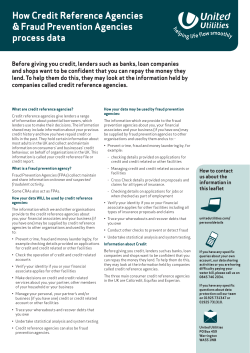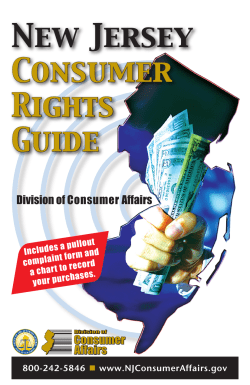
Criminal Litigation Track
Criminal Litigation Track Insurance Fraud: How to Define It and How to Prosecute It Co-Sponsored by the Insurance Benefits Committee and the New Jersey Business and Industry Association Moderator:Robert B. Hille, Esq. McElroy Deutsch Mulvaney & Carpenter, LLP Speakers: Joseph Brennan, Assistant Commissioner, Bureau of Fraud Deterrence New Jersey Department of Banking and Insurance Ronald Chillemi, NJ Insurance Fraud Prosecutor New Jersey Department of Law and Public Safety Loni M. Hand, Assistant Vice-President and Special Investigations Unit Director New Jersey Manufacturers Insurance Company John Kennedy, Office of the Insurance Fraud Prosecutor Office of the Attorney General Alex Kriegsman, Assistant United States Attorney Insurance Fraud Prosecutions New Jersey State Bar Association Annual Meeting Office of the Insurance Fraud Prosecutor Insurance Fraud Referrals Bureau of Fraud Deterrence (civil) Office of Insurance Fraud Prosecutor (criminal) Unified Referral System N.J.S.A. 17:33A-9 Any person who believes insurance fraud has occurred is required by law to refer the suspected fraud to OIFP and BFD Unified referral process for OIFP & BFD Unified Referral System OIFP CLASS – – – – OIFP (criminal) County Prosecutor (criminal) BFD (civil) Licensing Board (civil) DOBI DCA MVC Unified Referral System Appropriate use of resources Mutual assistance Deconfliction Fraud affects all types of insurance Life Commercial / Homeowners Workers Comp Auto Auto PIP Health Insurance Fraud: Costly Reality National healthcare spending: $2.34 trillion 3% fraud = $70 billion NJ healthcare spending: $70 billion 3% fraud = $2.1 billion Insurance Fraud: Costly Reality Healthcare costs Employers providing health benefits Insurance Fraud: Costly Reality “So strong an invitation to some is the country’s ever larger pool of health-care money that … law enforcement agencies and health insurers have witnessed … the migration of some criminals out of drug trafficking … and into the safer and far more lucrative business of perpetrating fraud schemes ….” Insurance Fraud: Costly Reality Survey of 753 P&C carriers: – Estimate that 15% of all claims are fraudulent in whole or part Metuchen dentist charged with falsifying dental records of 3 children, grandmother killed in South Plainfield fire — Middlesex County officials today charged a Metuchen dentist with falsifying the dental records of three of the four children killed in the Feb. 23 South Plainfield fire that also took the life of the children's grandmother. The false records delayed identification of the fire victims, Prosecutor Bruce Kaplan said in a joint statement with South Plainfield police Chief James Parker . . . . Criminal Statutes Crime of Insurance Fraud: – – – – KNOWINGLY Makes a false, fraudulent or misleading statement Of a MATERIAL fact In connection with an insurance claim or application Criminal Statutes Crime of Insurance Fraud: – KNOWINGLY: the person is AWARE THAT THE STATEMENT IS FALSE – MATERIAL: fact is relevant and important in determining the insurer’s course of action Criminal Statutes Crime of Insurance Fraud: – – 5 or more acts and $1,000 = second degree Second degree = state prison Criminal Statutes Health Care Claims Fraud – – – – KNOWINGLY or RECKLESSLY Makes a false, fraudulent or misleading statement Of material fact In connection with a claim for a health care service Criminal Statutes Health Care Claims Fraud: – – KNOWINGLY RECKLESSLY: consciously disregard a substantial and unjustifiable risk Criminal Statutes Health Care Claims Fraud: – – – Practitioner: licensed by the State to practice any profession Practitioner: 1 KNOWING violation, in course of profession = second degree Practitioner: 1 RECKLESS violation, in course of profession = third degree Criminal Statutes Theft by Deception – Purposely Obtain property belonging to another By deception – $75,000 or more = second degree – – Criminal Statutes Criminal Use of Runners – – – – For money Procures clients or patients In cooperation with a provider Whose purpose is to seek insurance benefits Criminal Statutes Commercial Bribery – – – – Give or receive Any thing of value For the knowing violation Duty of fidelity Lawyer, doctor, chiropractor Civil Statute Insurance Fraud Prevention Act – – KNOWINGLY make false material statement in connection with a claim or application KNOWINGLY use (or act as) a runner Civil Statute Rate Evasion: – – Apply for auto insurance Make a statement that the principal residence is in NJ, when it is not Civil Statute Penalties: – – – Up to $5,000 first violation; Up to $10,000 second violation; Up to $15,000 for each succeeding violation New Jersey False Claims Act Anyone can bring suit False claims to a state government program – Medicaid ; FamilyCare Recovery: triple damages plus penalty Plaintiff keeps: – – 15 to 25% of recovery (if AG prosecutes) 25 to 30% (if AG declines case) OIFP Reward Program 5% of fraud amount up to $25,000 max Information must lead to criminal conviction Case must be new (not already under investigation by any State entity) www.NJinsurancefraud.org Referring a Case Insurance fraud in a nutshell: LIE + MATERIALITY = FRAUD Referring a Case LIE – – – – – precisely what statement was false? who made that statement? how many false statements did the person make? what evidence shows the statement was false? what evidence shows the person KNEW the statement was false at the time it was made? Referring a Case MATERIALITY specifically how was the misrepresented fact important in determining course of action. – EG: affected coverage determination; affected amount of payment. what evidence shows the statement was material? Referring a Case Written summary of the fraud – Concise (2 or 3 pages) – – Who; what; when; where; how; and how do you know? Clearly identify the lies Quantify the loss: Claimed / paid Status of claim or application Any money recovered? Referring a Case Attach relevant documents – Refer to them in the concise written summary Tab or page number Referring a Case Reasonable suspicion: – Some facts / evidence such that a reasonable person would suspect fraud Reasonable likelihood of successful case – – – Evidence Elements Reasonable investigative steps What to include / exclude All evidence of: – – – Falsehood Knowledge Materiality What to include / exclude Statements and EUOs – Claim Notes: – – Include entire statement Relevant parts Preserve the rest Correspondence / Memos / Messages – If evidential: Falsehood; Knowledge; Materiality What to include / exclude Medical Bills – Police Reports – If they contain lies MVA; fire; theft Receipts / Invoices / Proof of Loss All Identifiers – – Name; address; DOB; SSN Corporate name; address; agents What to include / exclude OIFP CLASS, PO Box 094, Trenton NJ 08625-0094 NJinsurancefraud@NJDCJ.org GIVE DETAILS (attach documents!) 1-877-55-FRAUD Anonymous calls problematic Summary LIE + MATERIALITY = FRAUD Who; what; when; where; how How do you know that (what evidence is there) How much money is involved New Jersey Bar Association May 17, 2012 What is Insurance Fraud? An intentional act, or combination of acts, which involves such elements as deception, misrepresentation and/or concealment, for the purpose of wrongfully obtaining something of value from an insurance carrier Why do People Commit Insurance Fraud? People Tolerate Fraud & Don’t Think It Is Wrong Two of three Americans tolerate insurance fraud to varying degrees; Two of five Americans want little or no punishment for insurance cheats; they blame the insurance industry for its fraud problems because they believe insurers are unfair. Low Risk Crime Insurance fraud steals $80 billion every year With $80 billion, you could pay… salaries of 2.2 million American workers for a year. fund all cancer research in America for the next 13 years. tuition for nearly 15.6 million students at America’s four-year public universities for a year. buy a new car for nearly three million licensed drivers. That’s enough for every driver in New Jersey or Georgia. buy coffee and a bagel (with cream cheese) for every adult in New York City (6 million people) each morning for 20 years. Healthcare Fraud = $56 Billion Health system is an easy target. America's health care system is huge and vulnerable. The sheer number of patients and treatments plus complexity of billing attract cons who are skilled at looting our overworked health care system. The pressure to control costs also encourages many doctors or health firms to cheat so they can recoup lost profits or meet rigorous treatment quotas. Insurance Fraud Prevention Act / DOBI Regulations Carrier Fraud Suits Fraud Advisory Board Creation of SIUs Fraud Plans SIU Staffing Requirements & Qualifications Anti-Fraud Training Database SIU Referrals Referral Standard to OIFP/BFD Reasonable Suspicion of Fraud What Costs So Much? Limited cost control in PIP (vs. MCO) PIP Fee Schedule The Arbitration System Costs & Attorney’s Fees Litigation Collection Erodes Benefits Premiums Stay High Beyond Dollars & Cents Ineffective/Dangerous Treatment Unlicensed/Unqualified Providers Unnecessary Testing/Treatment Addiction What Takes So Long? Fraudsters don’t want to get caught Seeing the big picture (Pattern) Building a fraud case Developing a strategy Who Drives Medical Fraud? Insureds Claimants Witnesses Police Officers Runners Attorneys Medical Providers Fraud Schemes PIP Mills Staged Accidents/Paper Accidents Runners Billing for Services Not Rendered Upcoding Kickbacks Inflated Bodily Injury Settlements Prescription Fraud How to Deter Fraud? Pocketbooks Handcuffs Anti-Fraud Team Approach SIU NICB OIFP & L/E Prof. Boards BFD Proposed Fraud Bill A-944 (Riley/Milam); S-1461 (Vitale/Madden) Immunity Anti-Kickback 30-day Coolingoff Period Questions & Comments Loni Hand NJM Assistant Vice President & SIU Director (800) 232-6600, Ext. 5665 LHand@njm.com
© Copyright 2025





















